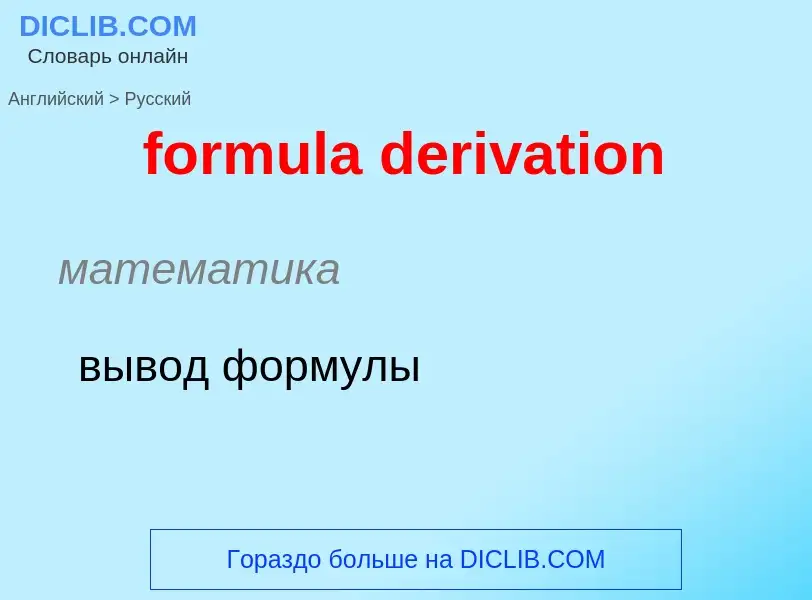Перевод и анализ слов искусственным интеллектом ChatGPT
На этой странице Вы можете получить подробный анализ слова или словосочетания, произведенный с помощью лучшей на сегодняшний день технологии искусственного интеллекта:
- как употребляется слово
- частота употребления
- используется оно чаще в устной или письменной речи
- варианты перевода слова
- примеры употребления (несколько фраз с переводом)
- этимология
formula derivation - перевод на русский
математика
вывод формулы
медицина
молочная смесь
общая лексика
формула корней квадратного уравнения
['fɔ:mjuli:]
общая лексика
от formula
- Air Transport Association formula
- approximation formula
- assumption formula
- basic formula
- COLA formula
- cost-of-living allowance formula
- economic lot-size formula
- Engset formula
- Erlang loss formula
- forecast formula
- general formula for capital
- interest formula
- interpolation formula
- inventory formula
- lot-size formula
- markup formula
- O'Dell formula
- optimum allocation formula
- order-quantity formula
- osculatory formula
- Paasche formula
- Pollaczek-Khinchine formula
- prediction formula
- recurrent formula
- short formula
- smoothing formula
- straight-line formula
- summation formula
- survival rate formula
- time formula
- Wilson formula
общая лексика
формула размерности
математика
антидифференцирование
Определение
Википедия
In elementary algebra, the quadratic formula is a formula that provides the solution(s) to a quadratic equation. There are other ways of solving a quadratic equation instead of using the quadratic formula, such as factoring (direct factoring, grouping, AC method), completing the square, graphing and others.
Given a general quadratic equation of the form
whose discriminant is positive, with x representing an unknown, with a, b and c representing constants, and with a ≠ 0, the quadratic formula is:where the plus–minus symbol "±" indicates that the quadratic equation has two solutions. Written separately, they become:
Each of these two solutions is also called a root (or zero) of the quadratic equation. Geometrically, these roots represent the x-values at which any parabola, explicitly given as y = ax2 + bx + c, crosses the x-axis.
As well as being a formula that yields the zeros of any parabola, the quadratic formula can also be used to identify the axis of symmetry of the parabola, and the number of real zeros the quadratic equation contains.
The expression b2 − 4ac is known as discriminant. If the discriminant is positive (b2 − 4ac ≥ 0) then it has two real square roots; otherwise, it has two complex roots. If a, b, and c are real numbers and a ≠ 0 then
- If b2 − 4ac > 0 then there are two distinct real roots or solutions to the equation ax2 + bx + c = 0.
- If b2 − 4ac = 0 then there is one repeated real solution.
- If b2 − 4ac < 0 then there are two distinct complex solutions, which are complex conjugates of each other.


![An [[infant]] being fed from a [[baby bottle]] An [[infant]] being fed from a [[baby bottle]]](https://commons.wikimedia.org/wiki/Special:FilePath/Flaskmatning.jpeg?width=200)


![Dijkstra, E.W.]] (July 1996), ''[https://www.cs.utexas.edu/users/EWD/transcriptions/EWD12xx/EWD1239.html A first exploration of effective reasoning]'' [EWD896]. (E.W. Dijkstra Archive, Center for American History, [[University of Texas at Austin]])</ref> Dijkstra, E.W.]] (July 1996), ''[https://www.cs.utexas.edu/users/EWD/transcriptions/EWD12xx/EWD1239.html A first exploration of effective reasoning]'' [EWD896]. (E.W. Dijkstra Archive, Center for American History, [[University of Texas at Austin]])</ref>](https://commons.wikimedia.org/wiki/Special:FilePath/Edsger Dijkstra 1994.jpg?width=200)
